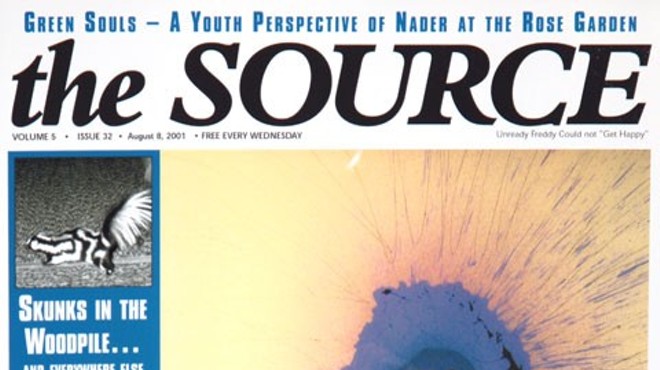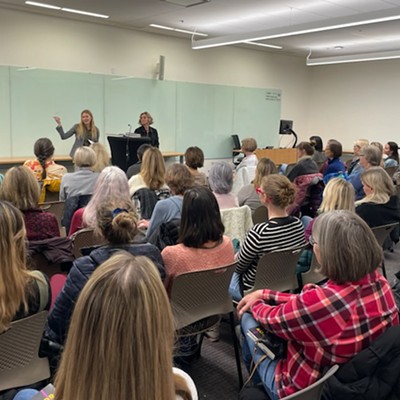Published Date: June 29, 2006
series of recent TV and newspaper ads run local builders and realtors associations have attacked the City of Bend's approach to developing Juniper Ridge, and questioned their choice of a master developer to lead the project.
There's been salvos in the other direction, too. Lead developer Ray Kuratek has blasted the development community in Bend and likened the climate here to doing business in Mississippi. Fighting words to be sure.
Former state representative Tim Knopp, now the executive director of the Central Oregon Builders Association, said the ads questioning the city and Kuratek are a product of "Citizens for Our Future," a Political Action Committee focused on educating the community on Juniper Ridge.
Although it looks to some like a smear campaign, the group isn't alone in looking for answers from the city, which has kept much about its dealings with Juniper Ridge under lock and key.
Back in August 2005, the City of Bend produced a concept plan for a 1,500-acre plot of land to the north of the city known as Juniper Ridge. The idea was to address the city's pent-up demand for industrial facilities, create jobs, and eventually build a master-planned research and development center and four-year university.
The concept was the result of a multi-year public process, receiving broad support from the general public and the local development and business communities. But when the city began shopping around for a master developer to help implement the plan late last year, the cozy relationship with the local business community got icy and fast.
Instead of about 150 acres of mixed use and residential development, as the plan originally called for, the city was now reportedly planning on developing the bulk of the usable land as a mixed use and residential, shifting the plan's emphasis sharply away from industrial. Critics, mostly from the building community, say the change has occurred behind closed doors.
There are also concerns that the city is prepared to hand the developer a windfall of cash, and that the plan is a financial risk to the community if not done right.
The first phase of Juniper Ridge, which amounts to about 500 acres— about 150 of which are to be used for infrastructure and open space — was supposed to alleviate the industrial problem, said Knopp. But now that the city is planning on throwing a substantial amount of residential development into the mix, the worry is that the supply won't go very far at all.
City Councilor John Hummel disagreed. "Even with the amount of mixed-use going in," said Hummel, "the first phase of the project will have a 17-year supply of industrial land." Hummel's numbers are based on the assumption that the demand for Juniper Ridge will be about 20 acres per year, a rate determined in a study completed in 1999-2000.
To further assuage the fears about the industrial land supply, Hummel added that no developers will be allowed to build residential or mixed-use before the pent-up demand for industrial is met. "We've told the developer that he can't lead with housing," said Hummel.
But according to Knopp, 20 acres per year is way too low and the study that figure is based on is, at the very least, outdated. He and others in the development community expect the actual absorption rate to be closer to 50 or 75 acres per year, meaning the first phase of Juniper Ridge may hold as little as five years worth of supply.
COBA has been charged by some in the community of being greedy, and upset that an "out-of-town" developer is snatching up a lot of work that might otherwise fall to local businesses. Knopp takes offense to such insinuations, saying that, "anyone who suggests this is making a ridiculous comment and trying to defend an untenable position."
The problem isn't that a master developer will control a sizeable portion of the project per se, he said, but with all the concerns about fair process and also a lack of a commitment to local builders—the group's proposal is stacked with out-of-area firms—he's worried that local builders will be cut out of claimed, said Lee; for now, it is the pie.
But according to City Councilor Jim Clinton, the city is planning on identifying industrial land within the next UGB expansion. Along with Hummel, Clinton believes Juniper Ridge won't be called upon to meet the entire demand. As for the development of the other 1000 acres in Juniper Ridge, or Phase II of the project, although the original plan called for more industrial acreage in addition to research and development, a university, and limited mixed-use, the current framework cuts industrial out almost all together.
Unlike those focused on industrial supply, Clinton and other councilors have decided to take a different approach to Juniper Ridge, one that maximizes the jobs-per-acre potential of the land.
To do that, said Hummel, the city has turned to a master-planned mixed-use concept that will create an attractive setting to lure in potential companies. Opening up raw land is fine for industrial needs, he said, but without an attractive master-planned environment with suitable housing, walkable streets, restaurants and the like, it's going to be very difficult to attract R&D-oriented companies and a four-year university, and the increase in jobs and revenue and benefits that they will bring.
Clinton agrees. When the city initially sent out a Request For Qualifications (RFQ) for the project, he said, three groups responded. Each group said the project would work only if it had more residential and mixed-use. The idea is that the restaurants, stores, parks and other attractions of a master-planned community will be difficult to support through employment-generated businesses alone. Without a certain number of local residents providing evening and night-time business provided by the local employment sector, said Clinton, the whole concept would be in jeopardy.
Clinton prefers not to look at the number of acres devoted to this or that, but rather at the fact that the city-preferred Juniper Ridge concept is predicted to create three jobs for every dwelling unit built there, far above the city average. "We're not excluding industrial," said Clinton. "It's being accommodated as part of a larger concept."
But it's an ambitious concept. "If we pull it off, we'll be better for it," acknowledged Mike Schmidt, the Bend Chamber of Commerce. "But will it work?"
Lee, whose specialty is in recruiting employers to Central Oregon, suggests that the concept is plausible, but many uncertainties remain. The city is geographically and socially isolated from the rest of the state, he pointed out, and the limited size of its workforce is a concern as a well. Land costs, construction costs, access to markets, quality of life and many other factors play a role when a business decides where to locate. For Bend to attract larger businesses, the city will need to pull together an attractive package, said Lee. A master-planned Juniper Ridge could be part of that package.
Still, "It's hard to know that this is the right path," Lee said.
Another source of tension is the lack of public involvement in the process which caused some to question the city's motives.
"It sure seems like this path was predetermined by someone," said Knopp, who feels that when the parameters of the project changed, the city should have opened the process back up. "We don't think there should have been a change in the first place," he said. "But if the plans are going to be different, we think it ought to go back to another RFQ out of fairness to everyone."
"If Kuratek wins, so be it," said Knopp, "at least it will have been a fair process."
Although Clinton argues that real estate deals and financial partnerships of this sort are always done out of the public eye, there's nothing preventing the city from discussing the details of the proposal. On that account Clinton feels the council could have done a much better job of educating the public on what he unwaveringly believes is a better vision for Juniper Ridge. Much of the confusion and dissent, he feels, is probably the result of poor communication.
One example, is that contrary to some public opinion, he said, the city will not be giving any land to the master developer. Another problem is uncertainty over how big a cut Kuratek's group is slated to receive.
The way a project like this usually works, said Kirk Schueler, president of Bend's Brooks Resources Corp., is that if one partner provides the land and another provides financial capital of the same value, the profits are split roughly 50-50.
But in this case the land is worth anywhere from $100 million to $500 million—depending who you ask—with Juniper Ridge Partners ponying up only about $30 million. Early reports on cost-sharing have the developer receiving 50% of the profit on a portion of the sales and then splitting the rest 70-30 in favor of the city.
Councilor Hummel claims those numbers are exaggerated, and the city will receive well over 60% of the profits. Yet if the land is worth, say, $200 million—a number that everyone seems to agree is within reason—and the city sold all of it at a 70-30 split, the developer would receive double its initial investment. That has guys like Knopp, Schmidt and Schueler worried that the city is short-changing the community.
While no one really questions the credentials of the Juniper Ridge Partners and its lead developer Kuratek, he certainly has ruffled a few feathers of late, especially among developers and realtors. According to Kathleen Leppert, a local realtor, and former member of the CDBG Housing Advisory Committee, Kuratek—who was also a member of the committee at the time, but later resigned—butted heads more than a few times over affordable housing issues and Juniper Ridge. When Kuratek accused certain members of being part of a good ol' boy network and standing in his way, many in the committee were offended.
His comments since, some of them to The Source Weekly, have been the subject of much conversation since, and featured in the TV ads run by the realtors and builders.
"I'm certainly not a good ol' boy," said Leppert, who remains adamantly opposed to the project's present course, if not the developer behind it. "I really don't care who develops Juniper Ridge," she said, "so long as the process is fair."
As Schueler pointed out, however, it's important to distinguish between qualifications and conduct. For what it's worth, he said, whatever animosity might exist it is likely to die down as the work comes in.
Schmidt agreed, saying that the city knew what it was getting into with Kuratek, who has a reputation for fiery behavior. "Is his mouth a concern? Well that's the downside of working with Ray. In San Mateo [where Kuratek developed another master-planned development] he got a little worked up as well, but he eventually cooled down and apologized for putting his foot in his mouth.
Some residents in San Mateo are still upset with Kuratek. One group, the "Friends of Bay Meadows" has even initiated a referendum against the developer, claiming among other things that while affordable housing was promised, none was delivered. The matter is still unresolved.
Schmidt went down to San Mateo himself and talked to the mayor, city manager, planning staff, and tenants, said, "They all said he did an excellent job."
Schmidt feels that because Kuratek is the front-man he's an easy target, and he left himself open to criticism by saying some dumb things. "He's passionate," said Schmidt, who was involved in Kuratek's interviews with the city, and helped give him the thumbs up, "and passionate people sometimes lose their cool."





















